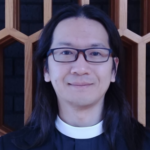Scholar Fridays is a weekly series on Bearings Online where we feature 2017-18 Resident Scholars. Susan Sink recently interviewed Toshihiro (Toppo) Takamura, who spent the academic year at the Collegeville Institute as a Resident Scholar. Takamura is a PhD Candidate at the United Lutheran Seminary (formerly Lutheran Theological Seminary at Philadelphia) in Pennsylvania. During his residency, he worked on his dissertation titled “Preaching the Gospel in a Time of Unrest: Martin Luther’s Biblical Hermeneutics in the Sermons of First Peter.” To view previous Scholar Friday interviews, click here.
What are Lutheran churches in Japan like? Are they very liturgical?

Toshiro (Toppo) Takamura
The history of Lutheranism in Japan is long and rich. It started in 1892 when the first missionary was sent from South Carolina. He was immediately followed by another missionary sent from Virginia and then a Danish Lutheran missionary via the U.S. joined them. In 1900, Finnish Lutheran missionaries came and started their work. It is significant that two among the early Finnish missionaries were teenage women. The ordination of the first Japanese pastor(s) took place in 1899. During the Second World War, the government forcibly organized all the Protestants (with few exceptions) into one church, which the Lutherans joined. After WWII, both American Lutherans and Finnish Lutherans left the aforementioned united church and became independent. Then, a number of Lutheran Churches sent their missionaries to Japan. Some of them, particularly from the US, collaborated with the Lutheran missions begun before the war and formed the JELC. The first female pastor was ordained in 1970. Today, there are about 120 congregations and 100 pastors. It is reported that there are about 20,000 registered members, but the active membership is somewhere around 8,000.
The question about liturgy is interesting, for the practice probably reflects that of the U.S. The post-WWII Christian missionary work was tactically planned, and different Lutheran missions started working in different regions and avoided competition. Regions evangelized by the low-church-oriented missions were less liturgical, but today most ordained ministers—if not all—wear a collar and alb. The standard liturgy used in the JELC was prepared in the 1980s and shows some influences of the Finnish Lutheran liturgical tradition, but currently, with the advisory help of Rev. Dr. Gordon Lathrop, a former Collegeville Institute scholar and a regular contributor to Worship (Liturgical Press), the JELC is in the process of renewing its liturgy.
It should also be noted that the JELC’s seminary in Tokyo is jointly operated by Nihon Ruteru Kyodan (NRK), a partner of the Lutheran Church-Missouri Synod (LCMS). This unique arrangement enables Lutherans of the JELC, NRK, ELCA, and LCMS to commune in worship there (special permission is granted by the LCMS, as I understand).
A lot of your religious training has been in the West, including a lot in Minnesota. How do you think that training will have to adapt or be supplemented in order to be a pastor to Japanese Lutherans?
My formal Christian training has happened “almost” entirely in the West, for while I started my study toward an MDiv degree here at the School of Theology in fall, 2005, I transferred to Japan Lutheran Theological Seminary in Tokyo and studied for another three years (including an internship) before ordination. This was more or less for the purpose of exposing me to the JELC and Japanese Christianity, and I appreciated it. Also, my MDiv thesis on the pre-WWII Lutheran missionary work in the JELC helped me to understand and appreciate the tradition to which I now belong.
I studied at the Lutheran Bible Institute of Seattle (Issaquah, WA) and completed a bachelor’s degree at Bethel College (St. Paul, MN; it is now Bethel University). I then came to Saint John’s for a summer monastic experience program and stayed here for the master’s degree. So, it is true that I spent a substantial portion of my theological training in Minnesota. I love Minnesota and am grateful that I am spending the final part of my study here again.
Two factors make Minnesota a special place for me: Saint John’s and the people. I studied at many places and Saint John’s is probably the only place where I felt a sense of stability. While many institutions and their atmosphere so easily changes from one year to another, Saint John’s, probably because of the monastic community, provides as its foundation something that does not change. It indeed offers something similar to what I feel at home. In terms of people, many of those whose friendship I cherish live in Minnesota, including Fr. Kieran Nolan, OSB, who came to my ordination in Tokyo. All those Minnesotans who are dear to my heart—both living and deceased—have exemplified in their lives the spirit of ecumenism and openness to cultural diversity, sometimes challenging my thinking and in other times giving me comfort and encouragement. Their examples lived out in tangible ways have guided me and will continue to guide me as I go back and work with the people in Japan.
In a previous conversation we had, I was interested to hear your thoughts on the difference between sacred spaces in Japan and the US. Could you say a little about that?
The sacred and the profane exist in every religious tradition. Since religion cannot be neatly separated from the reality in which we live, the sense of the sacred and the profane also exist virtually everywhere within and outside that religious framework (needless to say, civil religions also provide that sense). Here I will limit myself to the traditional religious frameworks of Christianity, Buddhism, and Shinto.
I perhaps first realized this whole issue when I learned about Japanese spirituality and its orientation to the land and the cycle of life—people were born in a place inherited from their ancestors, grew up, raised a family, died, and were buried on that property. This is not particularly unique to Japan, but such a sense of place and belonging is weak in the US with an exception of the Native American traditions.
Some people say that Shinto shrines well-maintained and tended by people have a distinct air from other shrines. It may be described as being pristine or even cool as one feels when hiking on mountains (one can tell that the temperature drops and becomes lower at certain places). A similar remark can be made about certain Buddhist temples and sites. While I felt something like this at shrines and temples in Japan, I have never felt it in the Christian churches of Japan and the US. This probably has nothing to do with one’s religiosity but the sites themselves. In other words, many of the religiously significant sites in Japan were chosen for because the sites themselves were considered religiously/spiritually special or different from other sites, while the sites of Christian churches in the US and in Japan are mostly chosen for their convenience and access of their community.
When I visited a ruin of a monastery in Geneva in Switzerland, I felt an air somewhat similar to this despite that the ruin was located in the city. Then, I remembered reading in hagiographies of the late-antiquity and the early medieval period how saints and Christians demolished “pagan” temples and shrines and on the same sites built Christian churches and monasteries. So, in Europe, too, people thought that religious/spiritual significance could be tied to certain sites.
It is also true in Japan that many of the religiously significant properties were built on the sites often donated by local rulers and the wealthy; they were often privileged sites. Needless to say, many places also acquired their special status for other reasons (a founder or famous leaders lived and/or trained there, etc.), but it is safe to assume that in some religious sites their religious significance, at least at first, resulted in the significance of the sites.
In recent years, some religious sites have become considered as “power-spot” where one can go and tap into and benefit from their supernatural power. While I do not appreciate the power-spot fervor especially in connection with commercial purposes, I can understand why people are attracted to certain places and feel something special.
Have you had any surprising conversations with other scholars during your stay? Anything that expanded your vision or gave you a glimpse into another view of religious experience?

I am grateful for meeting and getting to know all the Collegeville Institute scholars this year, but two people—both of them happened to be short-term scholars in fall—are especially. memorable. Ms. Lyz Lenz introduced me to the recent resurgence of the purity culture among Evangelicals. It is probably more accurate to say that it is a renewed interest, yet in a critical way by those who grew up under the influence of the purity culture popularized by Joshua Harris and his book I Kissed Dating Goodbye (1997). The book was becoming popular when I was in college. While I never read the book, I remember meeting people who read it at both the LBIS and Bethel College. I was a Baptist then and overwhelmed by the purity culture, especially because I had a secular, non-Christian background in Japan. After nearly twenty years I found revisiting the issue interesting and fascinating. The conversation with Ms. Lenz was intriguing, for she and I had a somewhat similar faith journey as Christians.
The other scholar was Prof. Rachel Miller-Jacobs and her project on “ordinary time” forgiveness (she also describes it as “quotidian forgiveness”). She pays attention to the tensions in interpersonal relationship taking place in everyday life, which may be considered by one party as an offense while by another not. So, one of the main challenges in this ordinary time forgiveness is that what could demand forgiveness is decided by criteria set subjectively, relatively, and fluidly, with nuances and subtlety. What makes her project interesting is that this is precisely what we face in the church as pastors (and most likely by anyone who holds a public office in the church). The current trend in pastoral ministry and care which encourages ministers to attend to the different needs and concerns from one person to another does raise new challenges, and therefore the project could benefit the church greatly.
Is there anything you wish I had asked but didn’t?
I would like to express my gratitude to three monks. I have already mentioned Fr. Kieran who came to my ordination in Tokyo (he was then a monk at Fujimi). Fr. Aelred Tegels, who died in 2003, also took good care of me; I took his name for my Oblate name. Lastly is Fr. Kilian McDonnell. When I was in the monastic experience program in summer 2001, he gave us participants a short lecture on ecumenism (the RC-Lutheran dialogue) probably because of me, a Lutheran participant among Catholics. I still remember him telling us that if he would try to attain salvation on his own he would fall flatly. He has been kind and encouraging to me since that first meeting, and I am grateful for his generosity. There are so many other monks at Saint John’s whom I like and even admire, and this positive experience and relationship propels me toward and deepens my commitment to ecumenism and its more tangible actualization.
Like this post? Subscribe to have new posts sent to you by email the same day they are posted.



Leave a Reply